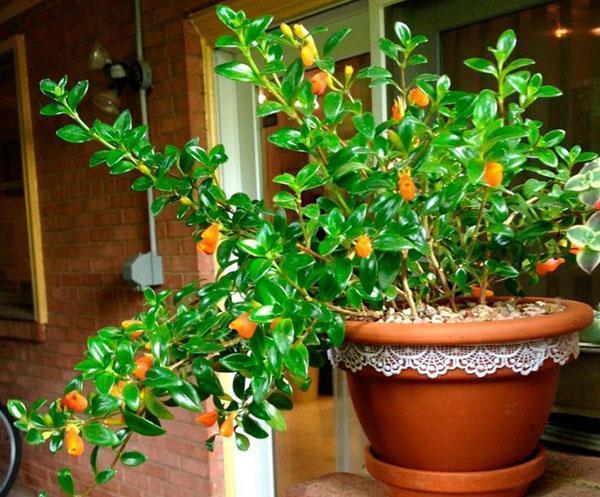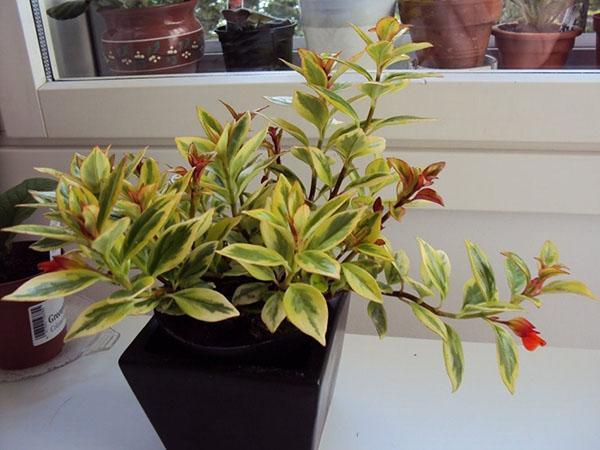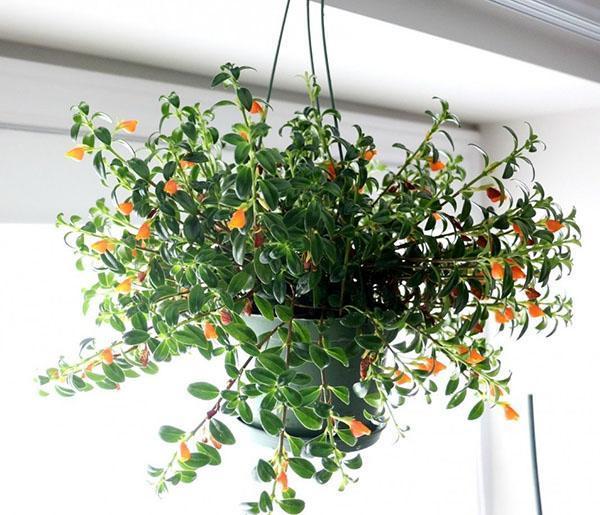Caring for nematanthus at home: planting, watering and lighting
 Caring for nematanthus at home is simple and not at all troublesome. The flower does not require special conditions or hourly watering. But, nevertheless, there are several features that you need to know before you bring home a beautiful plant.
Caring for nematanthus at home is simple and not at all troublesome. The flower does not require special conditions or hourly watering. But, nevertheless, there are several features that you need to know before you bring home a beautiful plant.
The native country of the nematanthus is Brazil, where it grew for many years until it was noticed by breeders. The flower itself curls, and is great for growing in planters and hanging pots, from where it will subside in beautiful waves.
In nature, nematanthus usually grows among fallen leaves, therefore it loves light, loose soil saturated with moisture. This must be taken into account when planting a flower at home. What other aspects you need to know in order to get a beautiful and healthy nematanthus at home, we will analyze in the article.
Planting a flower

First, let's prepare the ground. For nematanthus, soil and transplantation are very important moments of its life. To prepare the substrate, mix one part humus, the same amount of peat, and sand, add two parts of leafy earth to the mixture. Often more pieces of charcoal are added to it, but this is not at all necessary. It is this mixture for planting that will help the flower to actively develop and feed on all the necessary substances.
Fertilizer for nematanthus will not be superfluous. It is recommended to feed the plant every 2 weeks, and in winter every 4-6 weeks.
 Change the pot only when it has become too small for the flower. You should not transplant the nematanthus into a container that is much larger than the previous one. It will be enough to increase the diameter of the pot by a few centimeters. So, the root system will be able to master the entire soil quickly. In addition, if the roots of the flower are in a slightly compressed state, the outer part of the flower grows faster.
Change the pot only when it has become too small for the flower. You should not transplant the nematanthus into a container that is much larger than the previous one. It will be enough to increase the diameter of the pot by a few centimeters. So, the root system will be able to master the entire soil quickly. In addition, if the roots of the flower are in a slightly compressed state, the outer part of the flower grows faster.
Features of nematanthus care
 There are some features of caring for nematanthus, for the observance of which the flower will thank you with green, luscious foliage and abundant long-term flowering.
There are some features of caring for nematanthus, for the observance of which the flower will thank you with green, luscious foliage and abundant long-term flowering.
Provide good lighting for nematanthus. Diffused but bright light is perceived best by the plant. It is recommended to place the nematanthus on a window that faces west or east. If the window faces north, then the flower will not have enough light, as a result of which the leaves will lose color and juiciness, and the flowering will not be long.
Placing a nematanthus on a south window can cause sunburn, which will look like dark spots on the leaves and stop growing.
Light should hit the plant for at least 12 hours a day, and on especially hot days, the nematanthus should be covered with gauze or other translucent fabric.
Watering and air humidity for nematanthus need moderate. In the hot season, the flower should be watered regularly, but do not overflow. The earth must dry out, otherwise the root system will begin to rot. In winter, the number of water procedures should be reduced, let the plant rest. Do not worry that he will not have enough nutrients. It has accumulated a sufficient amount of vitamins and minerals in the leaves, and due to them it will winter well.
In winter, the number of water procedures should be reduced, let the plant rest. Do not worry that he will not have enough nutrients. It has accumulated a sufficient amount of vitamins and minerals in the leaves, and due to them it will winter well.
For watering, it is best to use purified water, or distilled water, at room temperature.
The temperature for nematanthus requires special attention. The flower is unpretentious, but a certain temperature regime must be observed, which will positively affect growth and flowering. During the period of active growth, in summer and spring, keep it warm. The temperature should be within + 22-26 degrees. In the daytime, the flower can withstand great heat, but at night the plant still needs rest and a decrease in temperature to recuperate. Therefore, if it is too hot in the house, then in the evening you can take the nematanthus outside.
 In the cold season, the minimum permissible temperature is 12 degrees Celsius. But prolonged exposure to such cold can be detrimental to the flower, so raise the temperature a little for normal plant wintering. It is best to adhere to the temperature regime within + 15-16 degrees.
In the cold season, the minimum permissible temperature is 12 degrees Celsius. But prolonged exposure to such cold can be detrimental to the flower, so raise the temperature a little for normal plant wintering. It is best to adhere to the temperature regime within + 15-16 degrees.
How a flower reproduces
 There are two ways to propagate a flower: cuttings and using seeds for planting. Let's analyze each of them in more detail:
There are two ways to propagate a flower: cuttings and using seeds for planting. Let's analyze each of them in more detail:
Cuttings of nematanthus can be done all year round. To do this, it is enough to take a piece of the stem, 10 cm long, peel it of the lower leaves, and transfer it to an airtight soil. You can put several shoots in one pot at once.
 For rooting, the cuttings will take an average of 10-12 days, after which the sprouts can be transplanted into separate pots, in which they will grow for the next year or several years.
For rooting, the cuttings will take an average of 10-12 days, after which the sprouts can be transplanted into separate pots, in which they will grow for the next year or several years.
Another way to reproduce is with seeds. They can either be purchased at a specialized store or prepared yourself. First, collect the seeds from the ripe bolls of the plant and dry them for several days on a regular sheet of paper.
While continuing to care for the nematanthus at home, prepare loose soil, make small indentations in it and sow a change in them. Then cover the pot with foil or glass, thereby creating the effect of a greenhouse. A pallet with wet expanded clay is placed under the bottom, which is periodically filled with water.
If everything is done correctly, then in 2-3 weeks you will see the first shoots. Dive them into a mixture that requires two parts peat soil and one part leafy soil to make. Once the seedlings are strong enough, they can be transplanted into their own pots.
As you can see, caring for nematanthus at home is not at all troublesome, it is enough to water the plant on time, provide it with daylight and feed it from time to time with the help of fertilizers. But in return for your efforts, you will receive an evergreen and long-flowering plant that will undoubtedly decorate your home.